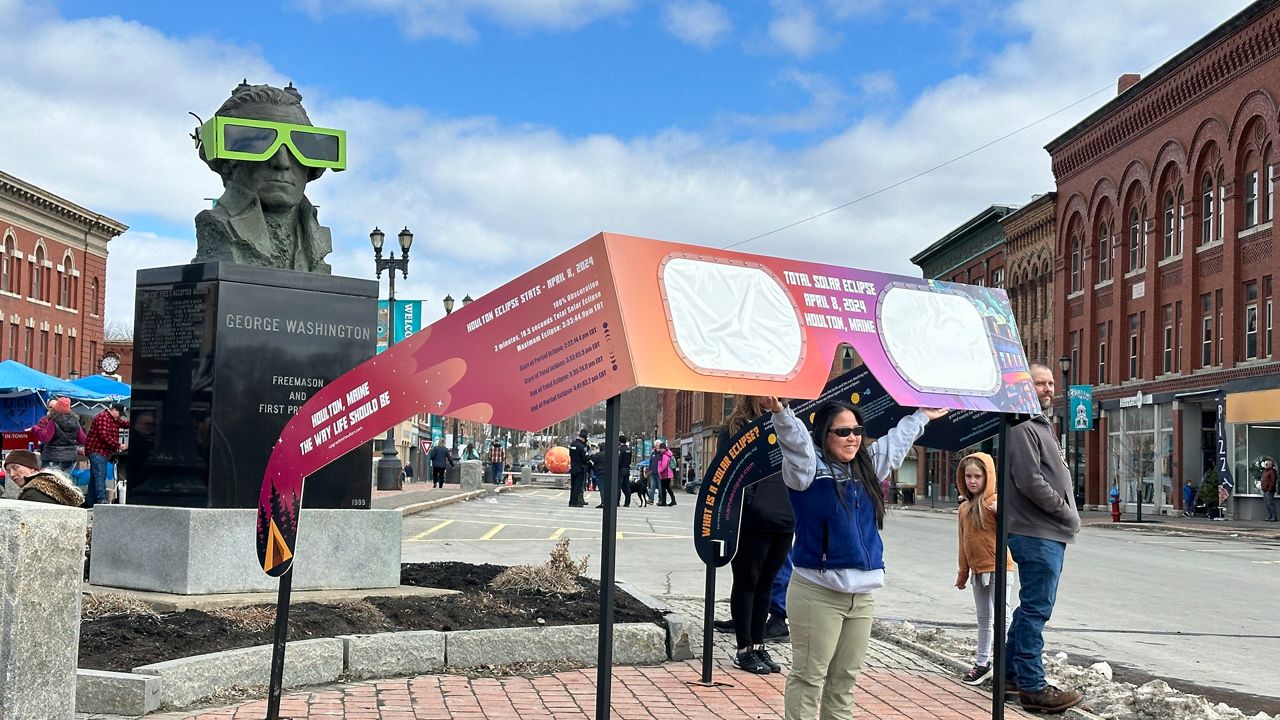The food trucks are in place, NASA is setting up and the sun is predicted to shine today in Houlton, a small town on the Canadian border prepared to welcome thousands to enjoy the total solar eclipse.
With a population of 6,000, Houlton is ready for 30,000 more people to come to town, the last place in the continental U.S. to see the eclipse.
The event motto: “The End is Here!”
Greater Houlton Area Chamber of Commerce Executive Director Jane Torres said Sunday the weather is beckoning others as well.
“We have nine private jets that have rerouted and are coming here tomorrow because they know we are having sun, sunshine,” she said.
For years, Houlton planned for today’s once-in-a-generation experience.
After studying 10 years of data, they knew 76% of the time, it’s cloudy.
Yet, they planned for the best, and 100 volunteers came forward to help ensure a safe and fun experience.
On Sunday, visitors enjoyed afternoon sun, a road race, food trucks, the Big Nazo Performance Group, and the BioBus, a place to explore all the cool parts of science.
Many took photos in front of a giant pair of eclipse glasses near the Freemason monument honoring George Washington, who also sported a large pair of green eclipse glasses.
For locals such as Quincy McGary, 30, and her family, Sunday presented a chance to enjoy eclipse events without fighting the traffic that’s sure to come today.
“We’re here to support our community,” she said.
With local schools canceled today, she and her three children may just enjoy the eclipse from the comfort of their own home.
“Our house kind of sits up on a hill so we hope to have a good view,” she said.
Others traveled a bit farther Sunday to take in the fun. Alice Chicoine, 71, of Windsor, drove 150 miles.
“It’s more fun to be where the action is,” she said.
With area hotels and rentals filled, Chicoine scored a timeshare in nearby Island Falls. And today, she plans to enjoy the eclipse from there rather than come back into town.
At a table near where NASA will livestream the eclipse, Sarah Kirn, citizen science strategist for NASA and the Gulf of Maine Research Institute, encouraged eclipse-goers to capture the event and share it with scientists.
“We don’t actually know the shape of the sun,” she said. “It’s squished one way or another.”
But using images from this eclipse, they will be able to get much more information about the sun, similar to what’s already known about the moon.
“They will be able to do some fancy geometry and figure out the shape of the sun for the first time,” she said.
Torres said organizers latched on to the eclipse as a selling point for the town as COVID-19 fears began to recede. With remote work an option for many more people, they hoped that those looking for a slower pace and small-town life might relocate to Houlton.
Following the eclipse, the chamber plans a follow up marketing push to transition the curious into the potential newcomers, she said.
The potential for growth is a welcome sign of hope for the town, which in the early 1900s was one of the top 10 wealthiest communities in the U.S. because of its growing potato and logging industries, according to the University of Maine.
Census data shows Houlton was never a large city, topping out at 8,300 people in the 1950s. Today it hosts the headquarters of the Houlton Band of Maliseet Indians and is where I-95 ends in Maine.
During World War II, the Army used part of the Houlton Army Air Base as a prisoner of war internment camp for 3,700 German prisoners of war. Today, the site is the local airport.
Some of those who come to the area today will see the eclipse from the airport, one of the designated “Star Parks” around town designed to help keep the downtown from overflowing with visitors.
For at least some of them, it’s likely to be the last total solar eclipse they see. The next one visible in North America is in 2044.
While welcoming visitors to Maine — and warning them to come prepared with paper maps and snacks — Gov. Janet Mills last week referenced the 1963 eclipse that drew an estimated 200,000 visitors to the state.
Why so many?
During that eclipse on July 20, 1963, Maine and Alaska were the only states in the path of totality.
This time around, Mills said she expects far fewer visitors because the eclipse will be visible in 15 states stretching from Texas through Missouri and Ohio before passing over a large swath of Maine.
And while she didn’t say exactly where she’ll be, other than somewhere in the path of totality, she encouraged everyone to enjoy the celestial spectacle.
“If you plan properly, you’re setting yourself up to have a great time and to enjoy this once in a generation event safely,” she said.









)